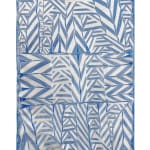Bandarr Wirrpanda
Further images
This work describes two areas. The first is Dhuruputjpi.
The Ancestral shark with the generic name of Mäna travelled country belonging to various Dhuwa clans who share ritual song of his journey. His travels started in Dhuwa country for the Djambarrpuyngu where he lived at Gurala. A Yirritja Ancestor called Murriyana and his wives came to hunt this place. The women when out to collecting oysters saw the shark with a special name of Dhakamawuy. The hunter speared the Shark, wounding him. Mäna left the country to travel an epic journey which is sung and at times reenacted by Dhuwa clan participants in ceremony.
He travelled, as great Creator Ancestors do, under ground to surface through water at various points of significance in north east Arnhem Land. At one such place in Yirritja land near Gängan he “heard the water coming through”. Mäna decided to leave this place and water for his waku (important kin relationship to the opposite moiety through a close female) he re-emerged not so far away at a place named Wandawuy #1, where he hit his head on a rock that marks this spot today. This is spoken of as Mäna transferring some power to the rock hence this place. Mäna moved on, as he had to many other places and on to many more including the islands of Groote and surrounds.
His resting place, however is this area of freshwater belonging to the Dhudi-Djapu clan. The waters of the great Wayawu river that usually are spoken of with a Manggalili/Yirritja clan reference ran into this place Rinydjalngu, so then the Shark, imbuing ownership to the Dhuwa. This is made clear by understanding that the sacred clan design woven into this panel represents the power of Gunduynguru in the freshwater belonging to the Dhudi – Djapu.
In this lower reach of the Wayawu the water banks up into massive billabongs of which Rinydjalngu is part. Feeling the need to rest, settle and populate the Shark swam through a special thicket of water palm, sung as Ḏarraŋgi (Hanguana malayana) that ceased his travels. This design is based upon this plant.
The second is Lutumba.
Ancestral hunters Balurruwuy and Yaŋgamawuy saw turtle from the island Burralku. This place with a more specific name of Marrtjirra as it is referred to in manikay (sacred song). From the Island the hunters prepared the harpoon and three splice fibre rope. The rope is sung Bungapumirr with the enchants Mamarrirrka for the art and ceremony of twisting of the rope, Yaltarr, Wurruku Mamikiya.
They saw the turtle Murrurrwa out past the batpa or coastal reefs of Burralku, out in the deeper seas of Lutumba.
“he thought the place was batpa but it was deep water but easily to see. When you get close to the turtle you can follow it under the water swimming to get away”
the large green turtle was killed.
“half way back he (they) saw Dhalwalarrmirr, Bundamirr. This is where the gapu (water) came up as rough sea Wulamba, Maŋaymaŋay, Djunu – Balamumu, Djapu Gapu”.
Dhalwalarrmirr, Bandamirr is the sacred rope with hook they saw stretched out on the surface of the roughening water and wuḏuku or driftwood is attached to such paraphernalia when used for hunting as a float marker. It connects the deep waters of Lutumba back to the Wukiti on the mainland.
These rough waters, dangerous and unforgiving drove the hunters back into the mainland, the massive tide covering the upper most land side aspects of Lutumba – the Wukiḏi or sacred burial ground for the Djapu, Dhudi Djapu, Marrakulu, Marraŋu and Dhapuyŋu
“Today when we finish buŋgul (ceremonial dance ) for somebody passed away we do the turtle hunt for the bukulup (water cleansing ceremony).”
People are placed in the prepared ground representing the Wukiḏi to have the giant ancestral tide wash/sung over them before the surge washes back to the sea – a spiritual connection and a cleansing.
The sacred nature of this place refers in part to the regeneration of Dhuwa souls via the medium of sacred waters that spring from this area.
The interlocking strips of miny’tji (sacred clan design) represent this water that is calm and clear – a turtle surfacing is easy to spot and chase.
This hunt is reenacted as a part of the larger mortuary rituals for the Djapu (and associates) deceased that has its origins at Lutumba.





